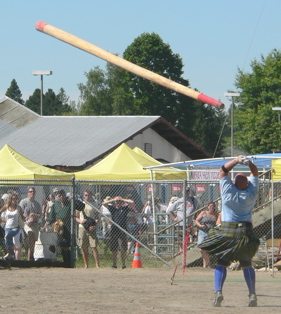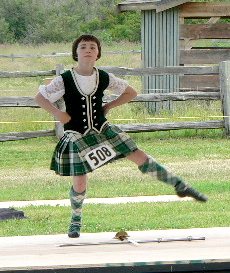|
HIGHLAND GAMES
|
|||||
|
HOME | BIOLOGY | FILMS | GEOGRAPHY | HISTORY | INDEX | INVESTORS | MUSIC | SOLAR BOATS | SPORT |
|||||
|
Highland games are festivals held throughout the year in Scotland and many other countries of the world as a way of celebrating Scottish and Celtic culture and heritage, especially that of the Scottish Highlands. Certain aspects of the games are so well known as to have become emblematic of Scotland, such as the bagpipes, the kilt, and the heavy events, especially the caber toss. While centered around competitions in piping and drumming, dancing, and Scottish heavy athletics, the games also include entertainment and exhibits related to other aspects of Scottish and Gaelic culture.
The Weight Throw
History
The origin of games and sports pre-dates recorded history and are the stuff of legend and stories. One common factor seems to be the need of primitive man to develop or to imitate, magically or otherwise, the skills necessary for survival in his society.
Games in the Highlands of Scotland
It is reported in numerous books and Highland games programs, that King Malcolm III of Scotland, in the 11th century, summoned contestants to a foot race to the summit of Craig Choinnich (overlooking Braemar). Some have seen in this alleged event the origin of today's modern Highland games.
There is a document from 1703 summoning the clan of the Laird of Grant. They were to arrive wearing Highland coats and "also with gun, sword, pistill and dirk". From this letter, it is believed that the competitions would have included feats of arms.
Revival or invention
Following the repeal of the Act of Proscription, various Highland Societies, beginning in the 1780s, began to organize around attempts to retain or revive Highland traditions. It was these early efforts that eventually led to the Highland Games as we know them today.
This modern revival of the Highland Games received an enormous boost with the visit of King George IV to Scotland in 1822, although events were held in the years just prior to that. In 1819, for example, the St. Fillans Society organized a full scale Highland games with piping, dancing, and athletics. The Northern Meeting Society's Highland Games the forerunner of The City of Inverness Highland Games was first held in 1822.
In the 1840s, in Braemar, Games began as a fund raising effort by local artisans to support a "Friendly Society" and their charitable activities. Soon thereafter, Queen Victoria who, together with her consort Prince Albert, had made Balmoral Castle their special retreat, began to patronize the Games. The Queen first attended the Braemar Games in 1848 and the following year, they were moved to the grounds of the Castle itself. Later, in 1868, the first in a series of "Highland Memoirs" excerpted from Victoria's Journals, would be published.
Together with the earlier 1822 event, Queen Victoria's patronage of the Games constituted one of the most significant factors in the popularization of the Games and what some have called the Highlandification of Scotland.
Among better-known games in Scotland are the ones held at Braemar, Inverness, Cowal, Lonach, Ballater and Aboyne. The Aboyne games have been running since 1867 without a break apart from the two world wars.
In the latter part of the 19th century, the Highland games played a role in the development of the Olympic movement. As part of his efforts to organize the first games, Baron Pierre de Coubertin visited a number of athletic competitions in order to determine which sports should be included in the forthcoming Olympic Games, to standardize rules, and to examine the technical aspects of running such a competition. Among the events he visited for this purpose were a Highland Games event organized in conjunction with the Paris Exhibition of 1889. That event, in addition to what we today would call track and field events, also contained wrestling, tug-of-war, cycling, as well as competition in piping and dancing.
Highland games traditional sporting event
Events
Heavy Events
In their original form many centuries ago, Highland games centered around athletic and sports competitions. Though other activities were always a part of the festivities, many today still consider Highand athletics are what the games are all about - in short, that the athletics are the Games, and all the other activities are just entertainment. Regardless, it remains true today that the athletic competitions are at least an integral part of the events and one - the caber toss - has come to almost symbolize the Highland games.
Although quite a range of events can be a part of the Highland athletics competition, a few have become standard.
Many of the competitors in Scottish highland atheltics are former high school and college track and field athletes who find the Scottish games are a good way to continue their competitive careers.
Increasingly in the USA, the Heavy Events are attracting women and Master class athletes which has led to a proliferation of additional classes in Heavy Events competitions. Lighter implements are used in the classes.
Music
For many Highland games festival attendees, the most memorable of all the events at the games is the massing of the pipe bands. Normally held in conjunction with the opening and closing ceremonies of the games, as many as 20 or more pipe bands will march and play together. The result is a thunderous rendition of traditional favorites Scotland the Brave or Amazing Grace, and other crowd-pleasing favorites.
It is, in fact, the music of the bagpipe which has come to symbolize music at the Games and, indeed, in Scotland itself. In addition to the massed bands, nearly all Highland games gatherings feature a wide range of piping and drumming competition, including solo piping and drumming, small group ensembles and, of course, the pipe bands themselves.
But the pipes and drums are not the only music which can be heard at Highland games. Music at Highland games gatherings takes on a variety of forms. Many such events offer fiddling, harp circles, Celtic bands and other forms of musical entertainment, the latter usually spiced with a healthy amount of bagpipe music.
A young highland dancer demonstrates her form in the sword dance at the 2005 Bellingham (Washington) Highland Games
Dance
There are two basic forms of dancing at modern Highland Games gatherings. Scottish country dancing is a social dance like ballroom dancing or square dancing, the latter of which evolved from country dancing.
The other type of dancing which one can see at Highland Games events is the highly competitive and technical form known as Highland dancing. This again takes two forms. First there are the traditional Highland dances - the Sword Dance (or Gillie Calum), the Highland Fling, the Highland Reel, and the Seann Triubhas (pronounced shawn trews). The other competition dances are known as national dances, the most well known of which are the Scottish Lilt, the Flora MacDonald, the Earl of Erroll, Highland Laddie, Blue Bonnets and Village Maid. Also common at the games are the Irish Jig and the Sailor's Hornpipe dances.
Highland dancing, in all its competitive forms, is a very technical dance form, requiring many hours of practice and training over a period of several years in order to perfect. It has more in common with ballet than with the social dancing of the Scottish Country Dance. In addition, the Highland dances are performed solo, unlike country dancing. Even the Reel, which is performed with other dancers, is judged on an individual basis.
Many Highland gatherings worldwide, and almost all in the United States, recognize the Scottish Official Board of Highland Dancing (SOBHD), formed in 1950, as the world governing body of Highland dancing. The SOBHD standardizes the dance steps, establishes rules for competitions and attire, certifies competitions and instructors and the like. In addition, a World Highland Dance Championship, sanctioned by the SOBHD, has been held annually at the Cowal Highland Gathering since 1948.
Historically, the Highland dances were danced only by men. This came about as the result of the nature and origin of the dances themselves as well as the fact that during the years of Proscription, only military regiments were permitted to adopt Highland attire and practice the traditions such as dancing.
But late in the 19th Century, a young woman named Jenny Douglas decided to enter a Highland dance competition. As this was not expressly forbidden, she was allowed to enter and since then, the number of females participating in the sport has increased until today in excess of 95% of all dancers are female. There have been several female World Highland Dance Champions crowned at the Cowal Gathering since they began organizing the competition in 1948.
Secondary events and attractions
At modern-day Highland Games events, a wide variety of other activities and events are generally available. Foremost among these are the clan tents and vendors of Scottish related goods. The various clan societies make the Highland games one of the main foci of their seasonal activities, usually making an appearance at as many such events as possible. Visitors can find out information about the Scottish roots and can become active in their own clan society if they wish.
At modern games, armouries will display their collections of swords and armour, and often perform mock battles. Various vendors selling Scottish memorabilia are also present selling everything from Irn-Bru to the stuffed likeness of the Loch Ness Monster.
Herding dog trials and exhibitions are often held, showcasing the breeder's and trainer's skills. In addition, there may be other types of Highland animals present, such as the Highland cattle.
Various traditional and modern Celtic arts are often showcased. This could include Harpist's circles, Scottish country dancing, and one or more entertainment stages. In addition, most events usually feature a pre-event ceilidh (a type of social event with traditional music, song, and other forms of entertainment).
Various food vendors will also offer assorted types of traditional Scottish refreshment and sustenance.
LINKS and REFERENCE
A - Z SPORTS INDEX
A taste for adventure capitalists
Solar Cola - a healthier alternative
|
|||||
|
This
website
is Copyright © 1999 & 2006 NJK. The bird |
|||||
|
AUTOMOTIVE | BLUEBIRD | ELECTRIC CARS | ELECTRIC CYCLES | SOLAR CARS |


